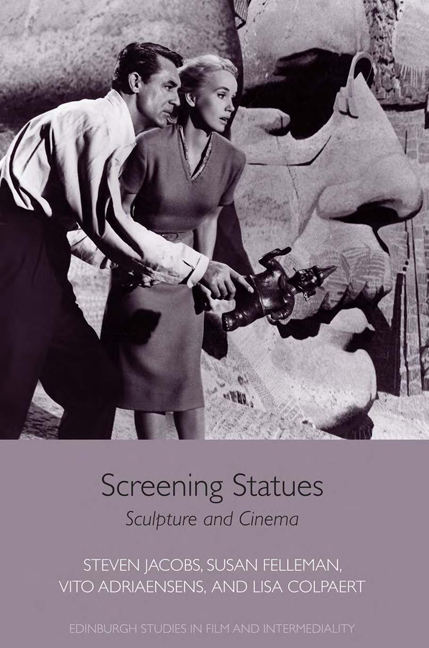Book contents
- Frontmatter
- Contents
- List of Figures
- Acknowledgements
- Introduction: The Marble Camera
- PART I
- 1 The Sculptor's Dream: Living Statues in Early Cinema
- 2 The Mystery … The Blood … The Age of Gold: Sculpture in Surrealist and Surreal Cinema
- 3 Carving Cameras on Thorvaldsen and Rodin: Mid-Twentieth- Century Documentaries on Sculpture
- 4 Anatomy of an Ovidian Cinema: Mysteries of the Wax Museum
- 5 The Night of the Human Body: Statues and Fantasy in Postwar American Cinema
- 6 From Pompeii to Marienbad: Classical Sculptures in Postwar European Modernist Cinema
- 7 Of Swords, Sandals, and Statues: The Myth of the Living Statue
- 8 Coda: Returning the Favor (A Short History of Film Becoming Sculpture)
- PART II
- Bibliography
- About the Authors
- Index
1 - The Sculptor's Dream: Living Statues in Early Cinema
from PART I
Published online by Cambridge University Press: 23 June 2018
- Frontmatter
- Contents
- List of Figures
- Acknowledgements
- Introduction: The Marble Camera
- PART I
- 1 The Sculptor's Dream: Living Statues in Early Cinema
- 2 The Mystery … The Blood … The Age of Gold: Sculpture in Surrealist and Surreal Cinema
- 3 Carving Cameras on Thorvaldsen and Rodin: Mid-Twentieth- Century Documentaries on Sculpture
- 4 Anatomy of an Ovidian Cinema: Mysteries of the Wax Museum
- 5 The Night of the Human Body: Statues and Fantasy in Postwar American Cinema
- 6 From Pompeii to Marienbad: Classical Sculptures in Postwar European Modernist Cinema
- 7 Of Swords, Sandals, and Statues: The Myth of the Living Statue
- 8 Coda: Returning the Favor (A Short History of Film Becoming Sculpture)
- PART II
- Bibliography
- About the Authors
- Index
Summary
In its earliest years of existence, cinema seems to have been fascinated by stasis and stillness. As if emphasizing its capacity to represent movement, early cinema comprises many scenes in which moving people interact with static paintings and sculptures. Moreover, films made shortly before and after 1900 often make explicit the contrast between the new medium of film and the traditional arts by means of the motif of the statue or the painting coming to life. In so doing, early film continued a form of popular entertainment that combined the art of the theater with those of painting and sculpture, namely the tableau vivant, or living picture. Focusing on the trick films of Georges Méliès and the early erotic films by the Viennese Saturn Company, this chapter reveals the importance and continuity of nineteenth-century motifs and traditions with regard to tableaux vivants as they were presented on the legitimate stage, in magic, in vaudeville, and in burlesque.
Living Statues in Moving Pictures
Tableaux vivants were certainly not always reproductions of famous paint¬ings, and they could be labeled with a variety of terms when billed, even if this meant a change in medium (from painting to sculpture), such as: living pictures, living statues, attitudes, poses plastiques, statues vivants, Venetian statues, Grecian statues, living statuary, tableaux, or marbres vivants. Many of these terms were, and still are, used synonymously. “Tableau vivant” is most commonly and generally used to denote the freezing of movement in a scene or on itself, be it on a stage or on a screen, to create an image that possesses the static qualities of a painting, whether symbolically, metaphorically, narra¬tively, aesthetically, or all of the above. Despite its variety, McCullough iden¬tified a few established conventions. Classic statuary and familiar paintings were top subjects, but these were complemented by recreations of literary and historical scenes.
- Type
- Chapter
- Information
- Screening StatuesSculpture and Cinema, pp. 29 - 45Publisher: Edinburgh University PressPrint publication year: 2017

